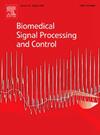MAPT基因变异对脑电活动的影响:一项多重网络研究
IF 4.9
2区 医学
Q1 ENGINEERING, BIOMEDICAL
引用次数: 0
摘要
本研究的目的是研究微管相关蛋白tau (MAPT)基因的变异如何影响大脑功能网络。为此目的,获得了155名参与者的静息状态脑电图(EEG)数据。该数据库包括健康对照组和阿尔茨海默病患者,他们携带7个MAPT等位基因,这些等位基因与神经病理学或异常tau水平的风险或保护作用相关。为了评估每种基因型对脑功能的影响,多路网络分析量化了每个脑区域在多个EEG频带(δ、θ、α和β)上的连接贡献。为此,首先使用相位滞后指数(PLI)参数计算每个脑区和频带的脑功能连通性。每个频带的PLI邻接矩阵对应于符合复用网络的层。随后,计算每个脑区的参与系数(P),以反映频带之间的节点度多样化。风险等位基因和保护性等位基因的携带者P值明显不同,特别是在健康对照的左默认模式网络中。此外,风险等位基因的携带者普遍表现出较高的网络中断。最后,在theta和beta频段的snp中观察到节点度值的显著差异。这些结果表明,不同的MAPT变异可能导致不同的tau物种影响大脑功能,特别是在临床前状态下涉及信息流管理的大脑区域。这些见解可能有助于理解由分子因素引起的网络干扰。本文章由计算机程序翻译,如有差异,请以英文原文为准。
Effect of MAPT gene variations on the brain electrical activity: A multiplex network study
The aim of this study is to examine how variations in the microtubule-associated protein tau (MAPT) gene affect the brain functional network. For this purpose, resting-state electroencephalogram (EEG) data from 155 participants were acquired. This database included healthy controls and Alzheimer’s disease patients carrying seven MAPT alleles associated with risk or protective effects against neuropathologies or abnormal tau levels. To assess the impact of each genotype on brain function, a multiplex network analysis quantified the connectivity contribution of each brain region across multiple EEG frequency bands: (delta, theta, alpha, and beta). To this end, brain functional connectivity was first calculated for each brain region and frequency band using the phase lag index (PLI) parameter. The PLI adjacency matrices in each frequency band corresponded to the layers conforming the multiplex network. Subsequently, the participation coefficient (P) was computed in each brain region to reflect node degree diversification among frequency bands. Carriers of risk and protective alleles exhibited distinct values of P, especially in the left default mode network in healthy controls. In addition, carriers of the risk alleles generally presented higher network disruptions. Finally, significant differences in node degree values were observed across SNPs in the theta and beta frequency bands. These results suggest that different MAPT variants may lead to diverse tau species that influence brain function, particularly in brain regions involved in information flow management in preclinical states. These insights may help understanding network disturbances caused by molecular factors.
求助全文
通过发布文献求助,成功后即可免费获取论文全文。
去求助
来源期刊

Biomedical Signal Processing and Control
工程技术-工程:生物医学
CiteScore
9.80
自引率
13.70%
发文量
822
审稿时长
4 months
期刊介绍:
Biomedical Signal Processing and Control aims to provide a cross-disciplinary international forum for the interchange of information on research in the measurement and analysis of signals and images in clinical medicine and the biological sciences. Emphasis is placed on contributions dealing with the practical, applications-led research on the use of methods and devices in clinical diagnosis, patient monitoring and management.
Biomedical Signal Processing and Control reflects the main areas in which these methods are being used and developed at the interface of both engineering and clinical science. The scope of the journal is defined to include relevant review papers, technical notes, short communications and letters. Tutorial papers and special issues will also be published.
 求助内容:
求助内容: 应助结果提醒方式:
应助结果提醒方式:


